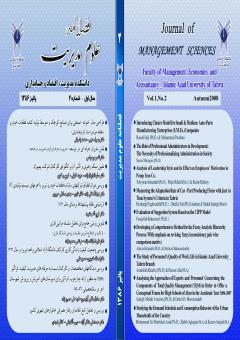طراحی مدل خوشه صنعتی برای صنایع کوچک و متوسط تولید کننده قطعات خودرو (مطالعه موردی استان آذربایجانشرقی)
محورهای موضوعی : مدیریت بازرگانی
1 - استاد و عضو هیئت علمی گروه مهندسی صنایع دانشگاه صنعتی شریف
2 - عضو هیئت علمی گروه مدیریت صنعتی دانشگاه آزاد اسلامی تبریز /دانش آموخته دکتری مدیریت صنعتی گرایش مدیریت سیستم، واحد علوم و تحقیقات دانشگاه آزاد اسلامی تهران
کلید واژه: زنجیره ارزش, خوشه صنعتی, بنگاههای کوچک و متوسط, ارائه دهندگان خدمات توسعه کسب و کار, ماتریس اسوات,
چکیده مقاله :
هدف این مطالعه بررسی ساختار بنگاههای کسب و کار کوچک و متوسطتولید کننده قطعات خودرو و تعیین روابط فی مابین این بنگاهها با یکدیگر، با تامین کنندگان، بازار و موسسات و نهادهای مالی و اعتباری، مراکز تحقیقاتی و علمی درقالب مطالعات خوشه های صنعتی جهت ارائه مدل توسعه خوشه ای میباشد.در این پژوهش با انجام مطالعات شناختی خوشهبروش میدانی و با استفاده از ابزارهای جمع آوری اطلاعات همچون پرسشنامه، مصاحبه، مشاهده و اندازه گیری عینی داده ها به تحلیل زنجیره ارزش فرآیندهای تولیدی و تعیین ماتریس نقاط قوت، ضعف، فرصتها و تهدیدات خوشه(اسوات) پرداخته شده است. در ادامه با استفاده از ابزارهای مدلسازی خوشه صنعتی بروش یونیدو، مدل پیشنهادی خوشه برای خوشه صنعتی قطعات خودروتبریز طراحی و ارائه شده است. یافته های پژوهش نشان می دهد که واحدهای کوچک و متوسط تولید کننده قطعات خودرو بدلیل عدم مشارکت گروهی در ساخت و ارائه محصولات با مارک مشترک، پائین بودن سرمایه اجتماعی ، عدم روابط سالم در بین تولیدکنندگان، ضعف روابط بین واحدها با تامین کنندگان، بازار و ارائه دهندگان خدمات توسعه کسب و کار و نیز عدم ارتباط صحیح با مراکز علمی و پژوهشی، نتوانسته اند از پتانسیل های موجود خود بهره برداری نمایند، لذا از نظر درآمد در وضعیت نامناسبی قرارگرفته اند و بسیاری از واحدها در آستانه ورشکستگی و تعطیلی می باشند. بنظر می آید چنانچه مالکان و مدیران بنگاهها بتوانند در چارچوب استراتژی خوشه و برنامه های عملی ارائه شده همکاریهای لازم را بنمایند در ظرف مدت زمانی 3 الی 4 سال آینده به وضعیت مطلوب دست خواهند یافت. مدل ارائه شده می تواند با اندکی تغییر و تعدیل در سایر خوشه ها بکار گرفته شود.
The aim of this study was to investigate the structure of small and medium auto – parts manufacturing enterprises and to determine the interrelationship of them, and their relationship with the suppliers, the market and financial institutes and creditors, and the scientific research centers in the form of industrial clusters in order to introduce the cluster development model. In this research project, a field research study of a cluster has been done by using various data collection methods such as questionnaires, interviews, observations and objective measurements in order to analyze the value chain of production processes and determine the matrix of strengths, weaknesses, opportunities and threats of cluster (SWOT). In continuation of the program, by using cluster modeling tools within UNIDO framework, the proposed cluster model of the auto parts industry for Tabriz was devised and developed. The findings have shown that small and medium enterprises of auto-parts, due to lack of mutual cooperations for producing common products, unavailability of sufficient capital and proper investments and also weak communications and weak business to business relationships, have not been able to take advantage of research programs available for them and this has resulted in diminishing businesses and many bankruptcies. If these enterprises can put their businesses into a healty and effective framework such as cluster strategy models, it would be possible to bring about a healthy situation within 3 to 4 years. The model produced can be easily adapted to many other different clusters.
Acs, Z. J. (1984). The changing structure of the U.S. economy New York: Praeger.
Acs, Z. J., & Audretsch, D. B. (1987). Innovation, market structure and firm size. Review of Economics and Statistics, 69 (4).
Acs, Z, J., & Audretsch, D. B. (1993). Small fims and Entrepreneurship: An east-west perspective. Cambridge: Cambridge University Press.
Acs, Z. J., Audretsch, D. B., & Feldman, M. P. (1994). R&D spillovers and recipient firm size. Review of Economics and Statistics.
Bhushan, K. (2006). Making clusters work, Unido Methodology, News Tech Publishing Inc.
Birch, D. (1981). Who creates jobs?. The public interest, 65.
Delawar, A. (2001). Theoretical and Practical Foundations of Research in the Humanities and Social Sciences. Tehran: Grow Publishing, (In Persian).
Fiqhili Farahmand, N. (2002). Dynamic Management of Organization. Tabriz: Forouzou Publication, (In Persian).
Hafez Nia, M. (2001). Introduction to the Research Method in Humanities. Tehran: Samt Publication, (In Persian).
Halt, I. W. (1994). Gross job flows in U.S. manufacturing US Bureau of the Census, Washington DC.
Majidi, J., & Shahabi, B. (2002). Industrial cooperation, industrial cluster and sustainable development. Tehran: Hezaran publications, (In Persian).
Pratten, C. (1991). The Competitiveness of Small Firm. (Cambridge: Cambridge University Press).
Sarkar, T. (2006). Working Together Works.Unido Publication for MSME Clusters.
Schmidt, H., Khalidandawi, E. & (2002). Industrial Clusters, a New Approach to Industrial Development. Translated by: A., Zandabov & A., Mokhberran, Tehran: New Design Publication, (In Persian).
Shoghaghi, A., & Shafiee, M. (2005). Document of Effective Contribution Partnership Strategy. Tehran: Rasa Publication, (In Persian).
Taqavi, N. (2002). Globalization and Development of Small and Medium Enterprises. Tabriz: Publication of the Project Society, (In Persian).
_||_


